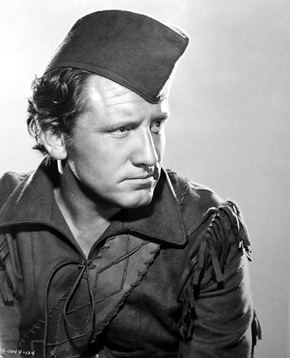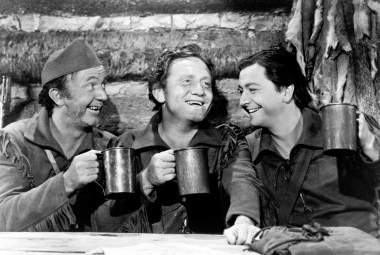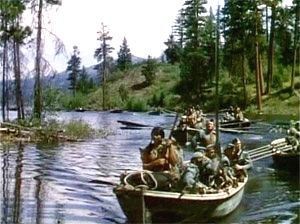
 |
|
|
|
An unusual release to come from MGM, 1940's Northwest Passage is an expensive epic depicting a military expedition in the French & Indian Wars. Despite being a vehicle for the studio's top star Spencer Tracy, it's director King Vidor's show all the way. Filmed on distant locations in the Northwest, whose untouched forests stood in for upstate New York in 1759, it was also an early workout for Technicolor, a filming ordeal almost as elaborate as a real army maneuver. A sizeable crew was needed just to cart the enormous Technicolor camera around -- the idea of lugging the 400-pound three-filmstrip monster up unpaved trails is no laughing matter. 
For its year Northwest Passage is odd in that it attempts to show exactly what it was like for revolutionary-era soldiers to march hundreds of miles into enemy territory. King Vidor had definite ideas about the horrors of war and expressed them in his silent classic The Big Parade. After a brief prologue in a colonial city, this picture concentrates on the unpleasant aspects of going to war. War was already breaking out in Europe during production. Perhaps Vidor was an isolationist, and wanted to impress upon young Americans just how bloody and cruel battle could be. The film's scenes of mass violence are fairly unprecedented -- and in crimson Technicolor, no less -- but what really sticks are its verbal descriptions of mutilation and torture. How did this get past the Production Code? The film is also a hard lesson to filmmakers about the risks of designing a multi-part movie. The show is actually titled Northwest Passage, Book 1 -- Rogers' Rangers, with the idea that a Book Two would continue the story. Judging from the obvious expense on screen, I'd say that MGM pulled the plug on any continuation. I also wouldn't be surprised to learn that Spencer Tracy was unwilling to go back for more -- he's never had a physical workout to equal this before or since. The story begins in New Hampshire town of Portsmouth. Aspiring artist Langdon Towne (Robert Young) has booted from Harvard for speaking his mind. The father of his sweetheart Elizabeth (Ruth Hussey) decides that he's a bad egg and forbids their association. When his drunken words offend the local corrupt town boss, Langdon and his jailbird friend Hunk Marriner (Walter Brennan) escape westward and join up with Major Robert Rogers (Spencer Tracy), the commander of an elite militia fighing for the British in Robin Hood-like green uniforms. "Rogers' Rangers" take boats and trek westward to strike at an Indian encampment. The strategy may be to draw French troops away from the fight with the British, but the Rangers' primary motive is to slaughter as many natives as possible, in retaliation for earlier murderous Indian raids. 
The expedition is harsh, to say the least. Rogers forces the men to march for days without food, for fear of detection or capture; injured men are left behind to die. Rogers deals harshly with troublemakers. He dismisses some of his Indian troops after confirming that they have been ordered by an officer back home to sabotage the mission. But the Rangers reach their target, a large village of enemy Abenaki Indians, undetected. They immediately set out on a full-scale massacre. Almost all of Northwest Passage takes place outdoors among beautiful landscapes of forests and lakes. Long lines of rowboats work their way upriver, and Rogers watches from the hills as boats of men in bright French uniforms pass in the other direction. The movie is very successful in communicating the idea that just a few miles past New York, the green forests stretch beyond the horizon, a seemingly limitless frontier for expansion. In a movie like this we expect to hear talk of grand motives for the future. We do get a bit of conversation about a future goal of finding a Northwest Passage to the Pacific, but in the context of the story that comes as pie-in-the-sky talk. John Ford would set up a spokesman to gab about opening the wilderness, building a nation, founding a great society. Major Rogers' soldiers don't know or care what the conflict with the French is all about, and instead fixate on the wholesale killing of Indians. Langdon enlists with the idea that he'll be able to sketch Indians in his spare time, and advance his standing as an artist. He listens as Rogers encourages veterans to tell the new soldiers about Indian atrocities -- raping women, chopping men up a bit at a time, braining babies, the works. One description of a prisoner having his ribs severed and pulled out one by one is almost too awful to picture, and seems unthinkably strong for a studio film from 1940. Rogers refers to these outrages to inspire maximum savagery from his troops. The general Indian Hate theme reaches its peak at the massacre, where we see the Rangers methodically exterminating almost all the braves (and there must be hundreds) in a beautifully recreated Abenaki village set at the side of a sizeable river. No Abenaki women or children are seen in this large encampment, which seems a way of sidestepping the unpleasant genocidal aspect of Rogers' surprise raid. The rest of the film depicts the terrible retreat under forced march and without provisions. Langford is shot in the midsection. He struggles to keep up with his comrades, even when helped by a rescued white prisoner (professional sufferer Isabel Jewell). She'd rather stay behind and remain an Indian, but Rogers won't permit it. The group splits up against Rogers' advice, only for the splinter parties to be ambushed by the enemy and slaughtered. Langhorne doesn't know if he'll make it, but Rogers encourages him to survive so he can see his sweetheart again. In a truly savage subplot, it is revealed that a mentally unbalanced Ranger (Donald MacBride) hasn't been going hungry. He carries with him the severed head of an Abenaki, and has been feeding from it. Even in the permissive '70s, they never did that to Alfredo Garcia! And this is a film from the MGM house of glamour? King Vidor surely had a lot of clout, to be able to make Northwest Passage the way he saw fit. 
What's puzzling us most is Vidor's un-ironic view of all this military carnage. The mission is never in doubt and Major Rogers' will never really falters. Men badly wounded, and one who has simply broken his leg in a fall, stay behind without complaint, knowing that they'll starve, or be killed by the enemy or maybe even wild animals. One of these is favorite actor Regis Toomey, whose friendly smile is immediately recognizable. When the troop finally makes contact again with the British allies, formal military etiquette is still observed. American life in the middle 1700s seems lively, violent and totally confusing when it comes to territorial disputes and fighting. Has anything changed? Filming only the first half of a two-part epic would cripple any enterprise. Northwest Passage is left with altogether too many severed story threads clearly meant to be resolved in the second installment: the politics back in Portsmouth and various intrigues in the British command itself, where a high ranking officer tries to arrange for Robert Rogers' expedition to be wiped out. This first show seemingly wraps up the involvement of Langdon Towne and Hunk Marriner, but the second half was reportedly to show Rogers' next campaign. It, we are told, was to finish as a failure or a tragedy. As it is, the image presented here of Major Robert Rogers differs from the quick summary offered in his Wikipedia entry -- it looks as if our noble hero eventually fought on the English side in the War of Independence! 
The Warner Archive Collection DVD-R of Northwest Passage is a good transfer of this early Technicolor epic, compromised somewhat by transfer elements with built-in flaws. The film's "original" negatives are three B&W registers from the Technicolor camera. In a perfect world, these three color records (if they have survived in good condition) would be scanned and recombined digitally, realigned and scaled to offset any shrinkage, and output to a fine new color negative and video master. This has been done for treasures like The Wizard of Oz but at present is just not feasible for titles not likely to return millions in rentals and sales. This is economic reality -- the new technical apparatus can rescue our film heritage, but not for free. So Northwest Passage has been transferred from a (presumed) Eastmancolor composite negative made at some time in the past. These very often look quite good, and when flaws show up it's generally during optical transitions or stray individual shots. In this picture many wide shots are 'out of register' -- that is, one of the color registers has shrunken so that the color values don't align properly. Most close-ups and medium shots look okay, but many wider angles show outlines or halos of color around objects. These distractions are built into the composite negative, so nothing can be done about them. It's just one of the things one must accept with some older color movies that have technical issues. Northwest Passage plays quite well. I only saw four or five angles where I really said, "this looks like 3D without the glasses". For an extra, the WAC has included a short promo called Northward, Ho!, which shows the enormous location work in Oregon and Idaho. An elaborate base camp in the forest is supplied by a brigade of trucks, and an army of grips are required to lug that monster camera around. We see it being positioned, and it doesn't look like easy work.
On a scale of Excellent, Good, Fair, and Poor,
Northwest Passage rates:
Reviews on the Savant main site have additional credits information and are often updated and annotated with reader input and graphics. Also, don't forget the 2011 Savant Wish List. T'was Ever Thus.
Review Staff | About DVD Talk | Newsletter Subscribe | Join DVD Talk Forum |
| ||||||||||||||||||